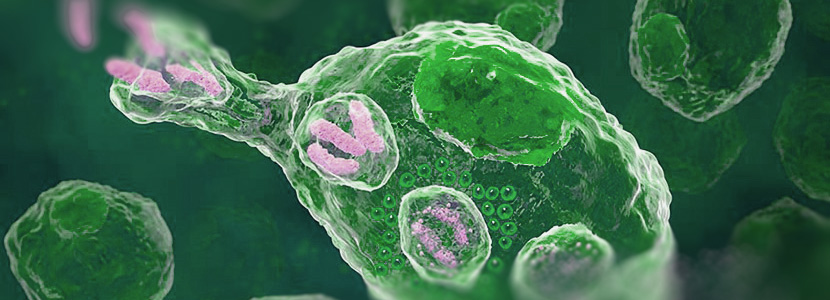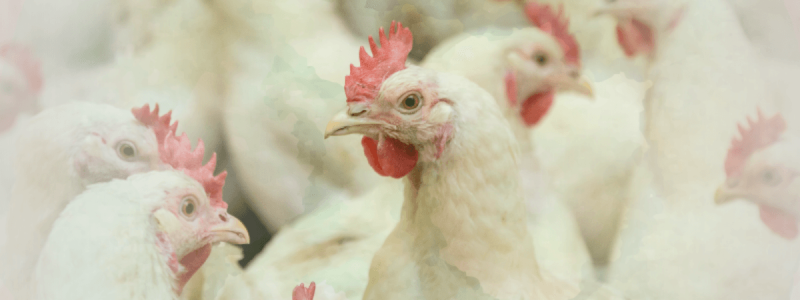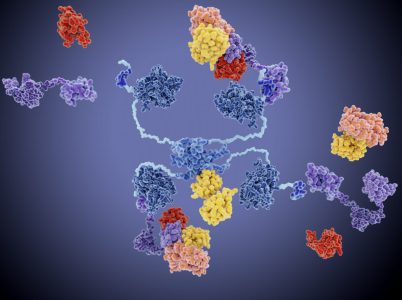 17 Feb 2023
17 Feb 2023
Antimicrobial peptides: an alternative for animal production. Part 2
In the first section of this article (Antimicrobial peptides: an alternative for animal production. part 1) we talked about Antimicrobial Peptides (AMP). These are molecules produced by various types of animal and plant cells, with great biological activity against bacteria, viruses and fungi. That first installment focused on the use of AMPs in swine. This second entry aims to review their inclusion in ruminants and poultry.
Ruminants

The rumen is an essential organ for nutrient fermentation due to its ability to produce end products, particularly short-chain fatty acids (SCFAs) and microbial protein. Which in turn represent the main source of energy and protein for ruminants(Kristensen et al., 2005).
Therefore, the optimization of ruminal fermentation will lead to the synthesis of more final products. As a result, studies in rumen manipulation have increased widely in recent years. The use of antibiotics can increase rumen efficiency; however, as in the pig industry, the long-term use of antimicrobials can be detrimental both for ruminants and consumers of their end products(Cheema et al., 2011).
Therefore, attempts have been made to replace them with better and safer alternatives. Similar to other animals, ruminants produce several AMPs with different sizes and mechanisms of action which act as innate natural barriers, Limiting microbial infections and other diseases(Brogden et al. , 2003).
Ruminants have 2 AMP groups which are present in different tissues:
1) Anionic peptides – a small group that is rich in aspartic and glutamic acids. These possess activity against Gram-negative and Gram-positive bacteria.
2) Cationic peptides –rich in proline and cysteine, with activity against Gram-positive and Gram-negative bacteria (Brogden et al., 1996, Brogden et al., 1997).
These peptides also have antiviral and antifungal activities (Jenssen et al., 2009). Some Gram-positive rumen bacteria can produce bacteriocins. These act as inhibitors for other bacterial species (Brogden et al. , 1997).
Broilers and layers

The presence of Salmonella spp. poses one of the biggest challenges within the poultry industry. Representing a serious hazard for animal health and public health (Narushin et al., 2020).In this regard, the defense mechanisms present in broilers and laying hens have been studied for several years.
This has led to the identification and classification of two large families of AMPs:
Defensins are composed b 18 to 45 amino acids, from which cystines are the most predominant. These possess the following properties:
Avian β-defensins (AvD) are produced by the activation of encoded genes in response to external or environmental factors. In laying hens, white eggs have been shown to possess antimicrobial and β-defensin proteins. In addition, a wide variety of cationically active AMPs have also been found to interact with the cell membrane of pathogens in broilers.
Galinacin-11 has demonstrated an effective response against S. typhimurium and Listeria monocytogenes in chickens (Higgs et al., 2005). Some ceratotoxins have shown great activity against multiresistant bacteria (Roque-Borda et al., 2021a).
![]()
A study by Ma et al. (2020) evidenced that the regulation of AMPs was influenced by the presence of probiotics in chickens. Showing an inversely proportional relationship in which AMP gene expression decreased as the concentration of probiotics increased.
Another important regulator can be the inclusion of yeasts, through which the expression of AMP encoding genes is increased. These molecules presented beneficial results for elderly laying hens. Demonstrating the benefits of supplementing older birds with this YC-combination (Zhang et al. , 2020).

Lactobacillins were also studied (Xu et al., 2020). These are polypeptides with antimicrobial activity produced by lactic acid bacteria (LAB).
Lactobacillus bacteriocin plantaricin K (PlnK) is part of this group. This peptide is particularly selective because it does not eliminate Gram-positive bacteria and exclusively eliminates pathogenic bacteria from the body. In addition, it does not alter the diversity of the intestinal microflora, This peptide is a specific promoter of intestinal microbial modulation and has become an subject of study for selective AMPs (Xu et al., 2020).
Other functions
Food preservative
AMPs have been applied in food preservation for more than 25 years. Bacteriocins produced by the LAB family have been the most studied, as they have potential applications in food preservation (Kareem and Razavi, 2020).
Treatment of bovine diseases
AMPs are considered as a new source of biomolecules in various fields of scientific research, given their potential activity against several pathogenic microorganisms.
![]() Bovine respiratory syncytial virus(BRSV) is considered a serious risk due to the economic losses associated with it.
Bovine respiratory syncytial virus(BRSV) is considered a serious risk due to the economic losses associated with it.
The Bovine respiratory disease complex (BRD) is one of the most common diseases in animal production caused by Mannheimia haemolytica, Histophilus somni and Pasteurella multocida. Cattle have a tracheal antimicrobial peptide (TAP) as a natural defense mechanism, which is affected and inhibited by stress generated from hormonal regulation in animal production(Siracusa, 2018; Vulikh et al. , 2019).
Therefore, current challenges are related to finding adequate carriers or formulations that allow peptide interaction with target pathogenic bacterium, without previous destabilization or degradation.

Conclusions
Advances in animal production, have increased the demand upon new additives that contribute to enhancing productivity while reducing mortality due to pathogens.
However, the indiscriminate use of antimicrobials and other growth promoters has revealed several unfortunate “side effects”. Including:
Antimicrobial peptides have proven to be efficient and promising. Exhibitting their applicability against various microorganisms in production animals. In addition to being suitable for their use in food preservation.
These multiple properties make them potential candidates for the replacement of conventional drugs.
| In addition, the development of new antimicrobials based on natural peptides for livestock, pigs and poultry can help reduce the problem of antimicrobial use without affecting animal production or human health. As well as reducing the presence of pharmacological residues and their environmental impacts. |
Subscribe now to the technical magazine of animal nutrition
AUTHORS

Nutritional Interventions to Improve Fertility in Male Broiler Breeders
Edgar Oviedo
The Use of Organic Acids in Poultry: A Natural Path to Health and Productivity
M. Naeem
Synergistic Benefits of Prebiotics and Probiotics in Poultry, Swine, and Cattle
Gustavo Adolfo Quintana-Ospina
Hybrid Rye Potential in Laying Hen Feed Rations
Gwendolyn Jones
A day in the life of phosphorus in pigs: Part I
Rafael Duran Giménez-Rico
Use of enzymes in diets for ruminants
Braulio de la Calle Campos
Minerals and Hoof Health in the Pregnant Sow
Juan Gabriel Espino
Impact of Oxidized Fats on Swine Reproduction and Offspring
Maria Alejandra Perez Alvarado